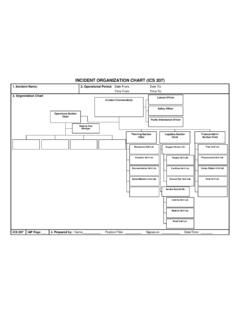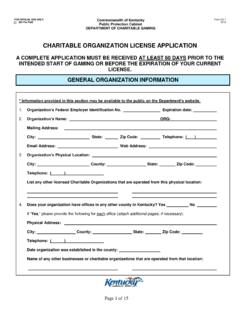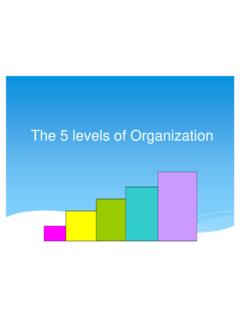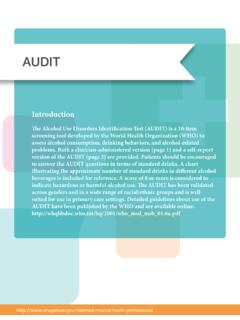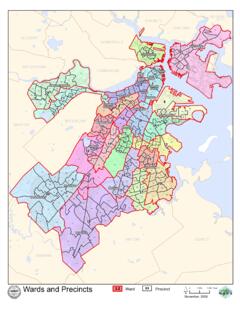Transcription of IRC 501(C)(6) Organizations - IRS tax forms
1 Exempt Organizations -Technical Instruction Program for FY 2003 IRC 501(c)(6) Organizations By John Francis Reilly, Carter C. Hull, and Barbara A. Braig Allen Exempt Organizations -Technical Instruction Program for FY 2003 IRC 501(c)(6) Organizations By John Francis Reilly, Carter C. Hull, and Barbara A. Braig Allen Overview Purpose This article discusses issues relating to the tax-exempt status under IRC 501(c)(6) of business leagues, chambers of commerce, boards of trade, and similar Organizations . As of March 31, 2002, there were 71,032 Organizations recognized as tax-exempt under IRC 501(c)(6). The Appendices contain checksheets and instructions for Project Code #206, 501(c)(6) Business Organizations .
2 Rules relating to the political campaign and lobbying activities of IRC 501(c)(6) Organizations are the subject of a separate article. In This Article This article contains the following topics: Topic See Page Overview 1 The Statute, Regulations and Analytical Framework of IRC 2 501(c)(6) Common Business Interest 6 Rules Regarding Membership and Support 12 Not Organized for Profit 15 Inurement 16 Improvement of Business Conditions 20 Activities That Constitute the Performance of Particular 24 Services Business Activities 32 Classification Issues 37 Appendices 41 Detailed Subject Directory 65 IRC 501(c)(6)
3 Organizations page K-1 Exempt Organizations -Technical Instruction Program for FY 2003 The Statute, Regulations, and Analytical Framework of IRC 501(c)(6) The Statute IRC 501(c)(6) provides for exemption of business leagues, chambers of commerce, real estate boards, boards of trade, and professional football leagues (whether or not administering a pension fund for football players), which are not organized for profit and no part of the net earnings of which inures to the benefit of any private shareholder or individual. Statutory The predecessor of IRC 501(c)(6) was enacted as part of the Tariff Act of History 1913.
4 Tariff Act of 1913, , II (G)(a), 38 Stat. 72. There is no legislative comment on the statute. It is generally assumed, however that its passage was the result of a Chamber of Commerce request for an exemption for nonprofit "civic" and "commercial" Organizations - a request that resulted in the enactment of what is now IRC 501(c)(4) (for nonprofit "civic" Organizations ) and IRC 501(c)(6) (for nonprofit "commercially oriented" Organizations .) See Hearings on Tariff Schedules of the Revenue Act of 1913 Before the Subcomm. of the Comm. of Finance, 63d Cong., 1st Sess. at 2001 (1913). The Revenue Act of 1928 amended the statue to specifically include real estate boards.
5 Rev. Act of 1928, ch. 852, 103(7), 48 Stat. 700. Most recently, in 1966, professional football leagues were added to the specifically described Organizations . Act of Nov. 8, 1966, Pub. L. 89 800, 6(a), 80 Stat. 1515. The Act, insofar as it related to professional football leagues, had both antitrust and tax provisions. The antitrust provision was enacted to permit the combination of the National and American Football Leagues to go forward without fear of an antitrust challenge under either the Clayton Antitrust Act or the Federal Trade Commissions Act. The IRC 501(c)(6) amendment was enacted to ensure that a professional football league's exemption would not be jeopardized because it administered a players' pension fund.
6 Conf. Rept. No 2308, 89th Cong., 2d Sess. (1966), reprinted in 1966-2 958, 963, 964. Continued on next page IRC 501(c)(6) Organizations page K-2 Exempt Organizations -Technical Instruction Program for FY 2003 The Statute, Regulations, and Analytical Framework of IRC 501(c)(6), Continued Regulations Reg. (c)(6)-l defines a business league as an association of persons having a common business interest, whose purpose is to promote the common business interest and not to engage in a regular business of a kind ordinarily carried on for profit. Its activities are directed to the improvement of business conditions of one or more lines of business rather than the performance of particular services for individual persons.
7 An organization whose purpose is to engage in a regular business of a kind ordinarily carried on for profit, even though the business is conducted on a cooperative basis or produces only sufficient income to be self-sustaining, is not a business league. Chambers of commerce and boards of trade are Organizations of the same general type as business leagues and the requirements for exemption of business leagues are the same for these Organizations . Reg. (c)(6)-l. However, chambers of commerce and boards of trade direct their efforts at promoting the common economic interests of all the commercial enterprises in a given trade or community.
8 See Rev. Rul. 73-411, 1973-2 180. Meaning of The term persons, as used in Reg. (c)(6)-1, includes legal entities such Persons in as trusts and corporations. the Regulations Remember, particularly when dealing with particular services, that Reg. (c)(6)-1 speaks in terms of services to persons, which refers not only to members, but also to individuals and entities who are not members. Continued on next page IRC 501(c)(6) Organizations page K-3 Exempt Organizations -Technical Instruction Program for FY 2003 The Statute, Regulations, and Analytical Framework of IRC 501(c)(6), Continued Basic To meet the requirements of IRC 501(c)(6) and Reg.
9 (c)(6)-1, an Characteristics organization must possess the following characteristics: of an IRC 501(c)(6) 1. It must be an association of persons having some common business organization interest and its purpose must be to promote this common business interest; 2. It must be a membership organization and have a meaningful extent of membership support; 3. It must not be organized for profit; 4. No part of its net earnings may inure to the benefit of any private shareholder or individual; 5. Its activities must be directed to the improvement of business conditions of one or more lines of business (discussed under The Line of Business Requirement, page 21) as distinguished from the performance of particular services for individual persons; 6.
10 Its primary activity does not consist of performing particular services for individual persons; and 7. Its purpose must not be to engage in a regular business of a kind ordinarily carried on for profit, even if the business is operated on a cooperative basis or produces only sufficient income to be self-sustaining. Continued on next page IRC 501(c)(6) Organizations page K-4 Exempt Organizations -Technical Instruction Program for FY 2003 The Statute, Regulations, and Analytical Framework of IRC 501(c)(6), Continued Analyzing the The characteristics listed above provide a useful structure for studying issues Characteristics raised under IRC 501(c)(6).










